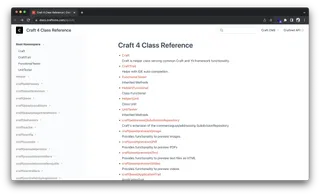Craft CMS and PHP: Exploring the Core


In the dynamic world of web development, two names often stand out: Craft CMS and PHP. Craft CMS, a powerful content management system, and PHP, a versatile programming language, have become integral tools for creating digital experiences. As a seasoned developer, I've seen firsthand how these technologies have evolved and shaped the industry. This article will delve into the heart of Craft CMS and PHP, exploring their histories, key features, and how they interact. We'll also venture into their core structures, advanced topics like performance optimization and security, and even real-world examples. Finally, we'll gaze into the future, discussing upcoming features and trends.
Craft CMS, a brainchild of the software development company Pixel & Tonic, began its journey in 2011. With a vision to enhance development and authoring experiences, the team behind Craft CMS introduced innovative concepts like Element Types, Live Preview, Matrix, and a practically limitless plugin architecture. Two years of dedicated work led to the release of Craft 1 in 2013. Since then, Craft CMS has been on a continuous journey of evolution, introducing improvements and new features, making it a reliable and user-friendly CMS.



Craft CMS stands out in the CMS landscape due to its unique features. It offers a powerful control panel that provides flexibility and control throughout the entire process. One of the key features is its flexible content modeling system, which allows you to design around your content. Craft CMS also provides user management tools, customizable fields, and support for multi-site installations. These features make Craft CMS a popular choice among web developers and content creators, offering a balance between simplicity and functionality.
Craft CMS is built with a flexible and user-friendly architecture. It supports two fundamentally different approaches to building a front-end: Monolithic, where templates are used to generate HTML on the server, and Headless, where APIs are used to deliver content to any type of client. Craft CMS provides a number of distinct building blocks, each appropriate for different kinds of content. Its modular architecture and customizable nature make it a highly scalable platform that can be optimized to handle various digital experiences. Whether you're looking to create a simple blog or a complex e-commerce site, Craft CMS's architecture is designed to accommodate your needs.
PHP, standing for PHP: Hypertext Preprocessor, was conceived in 1994 by Rasmus Lerdorf. Initially, it was a simple set of Common Gateway Interface (CGI) binaries written in the C programming language. Lerdorf used it for his personal page to track visitors. The first version used by others was available sometime in early 1995 and was known as the Personal Home Page Tools. Over the years, PHP has evolved significantly, with many new features and improvements added, making it one of the most popular server-side scripting languages in the world.
PHP is known for its simplicity, efficiency, and flexibility. It's an open-source language, meaning it's free to use and has a large community of developers contributing to its development. PHP is also platform-independent, which means it can run on any operating system. It offers excellent database connectivity and supports a wide range of databases. PHP is also a loosely typed language, which means you don't have to declare data types explicitly. These features, along with its speed and performance, make PHP a preferred choice for web development.
In the realm of web development, PHP plays a crucial role. As a server-side scripting language, PHP is used to create dynamic and interactive web pages. It allows web developers to create dynamic content and interact with databases, making websites more user-friendly and functional. PHP is also used for creating web-based applications and can be embedded into HTML code. Its simplicity, speed, and flexibility have made it a cornerstone in the web development world. From small websites to complex web applications, PHP's role in web development is significant and far-reaching.
PHP, standing for PHP: Hypertext Preprocessor, was conceived in 1994 by Rasmus Lerdorf. Initially, it was a simple set of Common Gateway Interface (CGI) binaries written in the C programming language. Lerdorf used it for his personal page to track visitors. The first version used by others was available sometime in early 1995 and was known as the Personal Home Page Tools. Over the years, PHP has evolved significantly, with many new features and improvements added, making it one of the most popular server-side scripting languages in the world.
PHP is known for its simplicity, efficiency, and flexibility. It's an open-source language, meaning it's free to use and has a large community of developers contributing to its development. PHP is also platform-independent, which means it can run on any operating system. It offers excellent database connectivity and supports a wide range of databases. PHP is also a loosely typed language, which means you don't have to declare data types explicitly. These features, along with its speed and performance, make PHP a preferred choice for web development.
In the realm of web development, PHP plays a crucial role. As a server-side scripting language, PHP is used to create dynamic and interactive web pages. It allows web developers to create dynamic content and interact with databases, making websites more user-friendly and functional. PHP is also used for creating web-based applications and can be embedded into HTML code. Its simplicity, speed, and flexibility have made it a cornerstone in the web development world. From small websites to complex web applications, PHP's role in web development is significant and far-reaching.

At its core, Craft CMS is built around the concept of elements, the most basic unit of content. It provides a flexible and intuitive structure that allows for easy content management. The core structure of Craft CMS includes various components such as sections, entries, and fields. Sections are the top-level containers for content, which can be of different types like Singles, Channels, and Structures. Entries are individual pieces of content that belong to a section. Fields are the smallest unit of content and can be of various types like text, date, number, and more. This core structure allows Craft CMS to offer a highly customizable and user-friendly content management experience.
PHP, as a server-side scripting language, has a unique core structure that allows it to handle a wide range of web development tasks. The basic structure of PHP code can be embedded within an HTML file, making it possible to create dynamic web pages. PHP's core structure includes variables, constants, expressions, operators, control structures, and functions. Variables in PHP are used to store data, constants hold values that do not change during the script execution, and expressions are the smallest units of code that can be executed. Control structures like if, else, and switch are used to control the flow of the code, and functions are reusable pieces of code. This core structure makes PHP a powerful and flexible tool for web development.

Craft CMS Class Reference website
Optimizing the performance of websites built with Craft CMS and PHP is a crucial aspect of web development. There are several strategies that can be employed to achieve this. First, ensure that your PHP environment is properly configured and up-to-date. PHP 7 and above offer significant performance improvements over previous versions. Second, Craft CMS itself provides several built-in features for performance optimization. For instance, Craft CMS has a robust caching system that can significantly improve the speed of your website. You can also leverage Craft CMS's eager loading feature to reduce the number of database queries. Additionally, optimizing your images and using a Content Delivery Network (CDN) can also contribute to faster page load times.
Security is a paramount concern when developing websites with Craft CMS and PHP. Craft CMS has several built-in security measures. For instance, it uses parameterized queries to prevent SQL injection attacks. It also uses bcrypt for password hashing, which is considered a highly secure method of password encryption. On the PHP side, it's important to keep your PHP environment up-to-date, as each new version includes security enhancements and fixes for known vulnerabilities. Furthermore, you should follow best practices for PHP development, such as validating and sanitizing user input, using secure PHP sessions, and employing proper error handling. Always remember, security is not a one-time task but an ongoing process.
Craft CMS and PHP have been used to create a multitude of successful websites. For instance, OneSignal, a leading provider of push notifications, recently launched their new website using Craft CMS. They chose Craft CMS for its flexibility and user-friendly interface, which allowed them to create a custom digital experience that met their specific needs. Another example is the website of Mambo Mambo, a creative agency, which showcases the versatility of Craft CMS in creating visually appealing and interactive websites. These real-world examples demonstrate the power and flexibility of Craft CMS and PHP in creating diverse and successful websites.
There are numerous success stories and lessons learned from using Craft CMS and PHP. OneSignal shared their experience of building their website with Craft CMS on Medium. They appreciated the flexibility of Craft CMS and how it allowed them to create a custom digital experience. They also highlighted the importance of keeping the PHP environment up-to-date for optimal performance and security. Another success story comes from the developers at Good Work, who have built over 100+ Craft CMS websites. They praised Craft CMS for its flexibility, ease of use, and robust features. These success stories and lessons learned provide valuable insights for anyone considering using Craft CMS and PHP for their web development projects.

Tom working in the studio
I'm excited to share what the future holds for Craft CMS and PHP. Craft CMS is continuously evolving, with new features being added to enhance its functionality. For instance, Craft 4, which was released in 2022, introduced a built-in "Money" field type and a new Twig filter for money. It also improved the control panel screens and controllers. As for PHP, it's also being updated regularly to improve its performance and security, making it even more reliable for web development.
Looking ahead, we can expect more innovative features to be added to both Craft CMS and PHP. These updates aim to make these tools more user-friendly and efficient, enabling developers to create more sophisticated and dynamic websites.
Now, let's look at some of the current and upcoming https://www.cmswire.com/digita.... One of the significant trends is the rise of intelligent content services, which automate responses and make content management more efficient. There's also a growing emphasis on post-pandemic flex work, which requires intuitive and flexible CMS platforms.
Another trend to watch is the increasing use of AI in CMS. AI can automate many tasks, making the CMS more efficient and user-friendly. There's also a growing demand for headless CMS architecture, which separates the front-end and back-end of a website, allowing developers to work on them independently.
In the broader web development industry, progressive web apps (PWAs), AI chatbots, and optimized voice search are some of the trends that are gaining traction. These trends reflect the industry's move towards more interactive and user-friendly web experiences.
As we move forward, it's essential to keep these trends in mind when working with Craft CMS and PHP. By staying updated with these trends, we can leverage the full potential of these tools and create websites that meet the changing needs of users.
In this article, we've journeyed through the world of Craft CMS and PHP, two powerful tools in web development. We've explored their histories, key features, and how they integrate to create dynamic digital experiences. We've delved into their core structures, discussed advanced topics like performance optimization and security, and shared real-world success stories. Finally, we've looked ahead at the future of these tools and the trends shaping the CMS and web development industry. As we continue to innovate and adapt in this digital age, Craft CMS and PHP remain at the forefront, offering endless possibilities for creating engaging, user-friendly websites. Keep exploring, keep learning, and harness the power of these tools to make your mark in the digital world.
I've been at Shape for around 8 years now. I bagged a couple of weeks of work experience at the end of my first year at Salford Uni and from then on, well what can I say, they couldn't get enough of me.